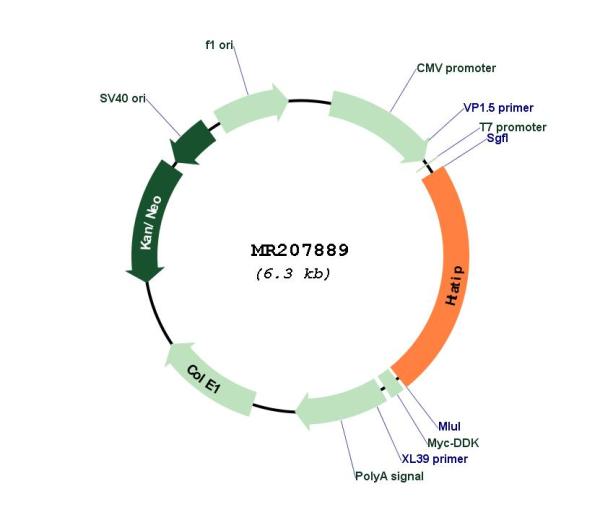Htatip (BC110675) Mouse Tagged ORF Clone
CAT#: MR207889
- TrueORF®
Htatip (Myc-DDK-tagged) - Mouse HIV-1 tat interactive protein, homolog (human) (cDNA clone MGC:117972 IMAGE:4011689)
ORF Plasmid: tGFP
Lentiviral Particles: DDK w/ Puro mGFP w/ Puro
AAV Particle: DDK
"BC110675" in other vectors (4)
Interest in protein/lysate? Submit request here!
USD 198.00
Specifications
| Product Data | |
| Type | Mouse Tagged ORF Clone |
| Tag | Myc-DDK |
| Symbol | Htatip |
| Synonyms | Tip60, PLIP, Htatip1, 60kDa, Tip55 |
| Vector | pCMV6-Entry |
| E. coli Selection | Kanamycin (25 ug/mL) |
| Mammalian Cell Selection | Neomycin |
| Sequence Data |
>MR207889 ORF sequence
Red=Cloning site Blue=ORF Green=Tags(s) TTTTGTAATACGACTCACTATAGGGCGGCCGGGAATTCGTCGACTGGATCCGGTACCGAGGAGATCTGCC GCCGCGATCGCC ATGGCGGAGGTGGGGGAGATAATCGAGGGCTGCCGCCTGCCCGTGCTGCGGCGCAACCAGGACAACGAAG ATGAGTGGCCCCTGGCTGAGATCCTGAGCGTGAAGGACATCAGTGGCCGAAAGCTTTTCTATGTCCATTA CATTGACTTCAACAAACGTCTGGATGAATGGGTGACTCACGAGCGGCTGGACTTAAAGAAGATCCAATTT CCCAAGAAAGAGGCCAAGACACCTACCAAGAACGGACTTCCTGGGTCCCGCCCCGGCTCTCCCGAAAGAG AGGTGCCGGCCTCCGCCCAGGCCAGCGGGAAGACCTTGCCAATCCCGGTCCAGATCACACTCCGCTTCAA CCTGCCCAAGGAGCGGGAGGCCATCCCAGGTGGCGAGCCTGACCAGCCGCTCTCCTCCAGCTCCTGCCTG CAACCCAACCACCGCTCAACGAAACGGAAGGTGGAGGTGGTTTCACCAGCAACCCCAGTGCCCAGCGAGA CAGCCCCAGCCTCGGTTTTCCCTCAGAATGGGTCAGCCCGTAGGGCAGTGGCAGCCCAGCCTGGACGGAA GCGGAAATCTAATTGCTTGGGCACTGATGAGGATTCTCAGGACAGCTCAGATGGAATACCGTCAGCACCA CGAATGACTGGCAGTCTGGTGTCTGACCGGAGCCACGACGACATTGTCACCCGGATGAAGAACATTGAGT GTATTGAGCTTGGCCGGCACCGCCTCAAGCCGTGGTACTTCTCCCCGTACCCACAAGAGCTTACCACGCT ACCCGTCCTCTACCTGTGCGAATTTTGCCTCAAATATGGCCGTAGCCTCAAGTGTCTGCAACGCCACTTG ACCAAATGTGATCTTCGGCACCCTCCAGGCAATGAAATTTACCGCAAGGGCACCATCTCCTTTTTTGAGA TTGATGGACGGAAAAACAAGAGTTACTCACAAAACCTGTGTCTTCTGGCCAAGTGTTTCCTGGACCACAA AACACTGTACTATGACACTGACCCCTTCCTCTTCTACGTAATGACGGAGTATGACTGCAAAGGTTTCCAC ATCGTGGGCTACTTCTCCAAGGAAAAGGAATCCACAGAAGATTACAATGTGGCCTGCATCTTGACTCTGC CTCCCTACCAGCGCCGGGGCTATGGCAAGCTGCTTATTGAGTTCAGTGAGTATGTGCTGCCTGACCAGGA GCTGGCAGGCCAAGCCTGTGTGGGTCCCATTCTGCTGAGAGCAGCTGGCGTTCCCAGGATCGCAGCTAAA CTGATGACACTGAAAAGGTTCCCATGTCCTCAGACCACAAAGGGCTCCCTCATTACTGCCATACACCCAG ACACAGGCTGGCAGGGCAGCGACCCATCCTGGCAGCCTTCACTGGCTGACAAGTACCCAACCGGAGCTGC TCTTCTAGCCTTTGGCCCCCAACACTGCAGACAGGGAAGCTGCTGGTCCACACCAAGAGCTATGAACTCT CGAAAG ACGCGTACGCGGCCGCTCGAGCAGAAACTCATCTCAGAAGAGGATCTGGCAGCAAATGATATCCTGGATT ACAAGGATGACGACGATAAGGTTTAA >MR207889 protein sequence
Red=Cloning site Green=Tags(s) MAEVGEIIEGCRLPVLRRNQDNEDEWPLAEILSVKDISGRKLFYVHYIDFNKRLDEWVTHERLDLKKIQF PKKEAKTPTKNGLPGSRPGSPEREVPASAQASGKTLPIPVQITLRFNLPKEREAIPGGEPDQPLSSSSCL QPNHRSTKRKVEVVSPATPVPSETAPASVFPQNGSARRAVAAQPGRKRKSNCLGTDEDSQDSSDGIPSAP RMTGSLVSDRSHDDIVTRMKNIECIELGRHRLKPWYFSPYPQELTTLPVLYLCEFCLKYGRSLKCLQRHL TKCDLRHPPGNEIYRKGTISFFEIDGRKNKSYSQNLCLLAKCFLDHKTLYYDTDPFLFYVMTEYDCKGFH IVGYFSKEKESTEDYNVACILTLPPYQRRGYGKLLIEFSEYVLPDQELAGQACVGPILLRAAGVPRIAAK LMTLKRFPCPQTTKGSLITAIHPDTGWQGSDPSWQPSLADKYPTGAALLAFGPQHCRQGSCWSTPRAMNS RK TRTRPLEQKLISEEDLAANDILDYKDDDDKV |
| Restriction Sites |
SgfI-MluI
Cloning Scheme for this gene
Plasmid Map

|
| ACCN | BC110675 |
| ORF Size | 1476 bp |
| OTI Disclaimer | The molecular sequence of this clone aligns with the gene accession number as a point of reference only. However, individual transcript sequences of the same gene can differ through naturally occurring variations (e.g. polymorphisms), each with its own valid existence. This clone is substantially in agreement with the reference, but a complete review of all prevailing variants is recommended prior to use. More info |
| OTI Annotation | This clone was engineered to express the complete ORF with an expression tag. Expression varies depending on the nature of the gene. |
| Product Components | The ORF clone is ion-exchange column purified and shipped in a 2D barcoded Matrix tube containing 10ug of transfection-ready, dried plasmid DNA (reconstitute with 100 ul of water). |
| Reconstitution | 1. Centrifuge at 5,000xg for 5min. 2. Carefully open the tube and add 100ul of sterile water to dissolve the DNA. 3. Close the tube and incubate for 10 minutes at room temperature. 4. Briefly vortex the tube and then do a quick spin (less than 5000xg) to concentrate the liquid at the bottom. 5. Store the suspended plasmid at -20°C. The DNA is stable for at least one year from date of shipping when stored at -20°C. |
| Reference Data | |
| RefSeq | BC110675, AAI10676 |
| RefSeq Size | 2350 bp |
| RefSeq ORF | 1478 bp |
| Locus ID | 81601 |
| Cytogenetics | 19 A |
| MW | 55.3 kDa |
| Gene Summary | Catalytic subunit of the NuA4 histone acetyltransferase complex which is involved in transcriptional activation of select genes principally by acetylation of nucleosomal histones H4 and H2A (By similarity). This modification may both alter nucleosome-DNA interactions and promote interaction of the modified histones with other proteins which positively regulate transcription (By similarity). This complex may be required for the activation of transcriptional programs associated with oncogene and proto-oncogene mediated growth induction, tumor suppressor mediated growth arrest and replicative senescence, apoptosis, and DNA repair (By similarity). NuA4 may also play a direct role in DNA repair when recruited to sites of DNA damage (By similarity). Component of a SWR1-like complex that specifically mediates the removal of histone H2A.Z/H2AFZ from the nucleosome (By similarity). Also acetylates non-histone proteins, such as ATM, NR1D2, RAN, FOXP3, ULK1 and RUBCNL/Pacer (PubMed:22539723). Directly acetylates and activates ATM. Relieves NR1D2-mediated inhibition of APOC3 expression by acetylating NR1D2 (By similarity). Promotes FOXP3 acetylation and positively regulates its transcriptional repressor activity. Acetylates RAN at 'Lys-134' (By similarity). Together with GSK3 (GSK3A or GSK3B), acts as a regulator of autophagy: phosphorylated at Ser-86 by GSK3 under starvation conditions, leading to activate acetyltransferase activity and promote acetylation of key autophagy regulators, such as ULK1 and RUBCNL/Pacer (PubMed:22539723).[UniProtKB/Swiss-Prot Function] |
Documents
| Product Manuals |
| FAQs |
| SDS |
Resources
Other Versions
| SKU | Description | Size | Price |
|---|---|---|---|
| MC217931 | Htatip (untagged) - Mouse HIV-1 tat interactive protein, homolog (human) (cDNA clone MGC:117972 IMAGE:4011689), (10ug) |
USD 150.00 |
|
| MG207889 | Htatip (tGFP-tagged) - Mouse HIV-1 tat interactive protein, homolog (human) (cDNA clone MGC:117972 IMAGE:4011689) |
USD 657.00 |
|
| MR207889L3 | Lenti ORF clone of Htatip (Myc-DDK-tagged) - Mouse HIV-1 tat interactive protein, homolog (human) (cDNA clone MGC:117972 IMAGE:4011689) |
USD 757.00 |
|
| MR207889L4 | Lenti ORF clone of Htatip (mGFP-tagged) - Mouse HIV-1 tat interactive protein, homolog (human) (cDNA clone MGC:117972 IMAGE:4011689) |
USD 757.00 |
{0} Product Review(s)
Be the first one to submit a review






























































































































































































































































 Germany
Germany
 Japan
Japan
 United Kingdom
United Kingdom
 China
China


